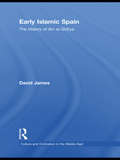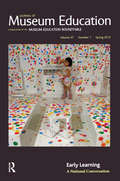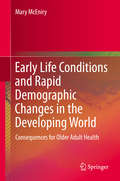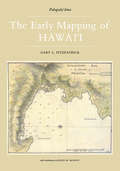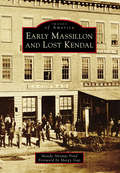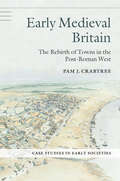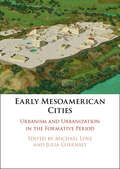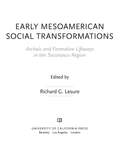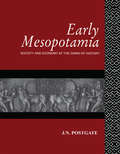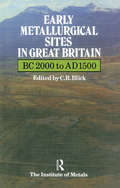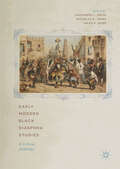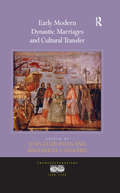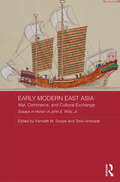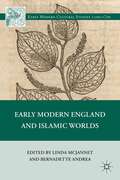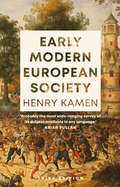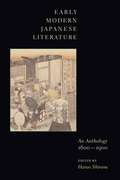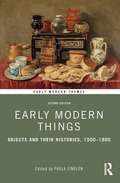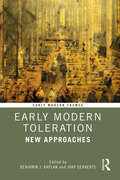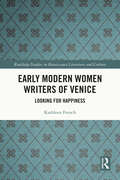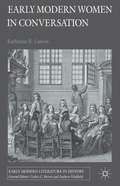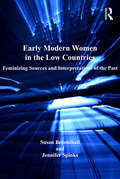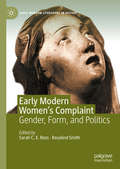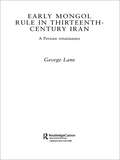- Table View
- List View
Early Islamic Spain: The History of Ibn al-Qutiyah (Culture and Civilization in the Middle East)
by David JamesThis book is the first published English-language translation of the significant History of Islamic Spain by Ibn al-Qutiya (d. Cordova 367 / 977). Including extensive notes and comments, a genealogical table and relevant maps, the text is preceded by a study of the author and his work, and is the only serious examination of the unique manuscript since Pascual de Gayangos’ edition in 1868. Ibn al-Qutiya’s work is one of the significant and earliest histories of Muslim Spain and an important source for scholars. Although like most Muslims of al-Andalus in this period, Ibn al-Qutiya was of European origin, he was a loyal servant of the Iberian Umayyads, and taught Arabic, traditions (hadith) and history in the Great Mosque of Cordova. Written at the height of the Umayyad Caliphate of Muslim Spain and Portugal (al-Andalus), the History describes the first 250 years of Muslim rule in the peninsula. The text, first fully translated into Spanish in 1926, deals with all aspects of life, and includes accounts of Christians, Jews and Muslim converts. This book will be of great interest to scholars and students of the history of Spain and Portugal, Islamic history, and Mediaeval European history.
Early Learning: Journal of Museum Education 37:1 Thematic Issue
by Laura Roberts Mark Larson Scott Pattison Tina R. Nolan Cynthia Robinson Amelia Chapman Maria Del Carmen Cossu Mary Kay Cunningham Karen L. Daly Brook Digiovanni Evans Erik Holland Mark Howell Carole Krucoff Beth Maloney Alexa Miller Julia Rose Tania Said Schuler Susan Spero Hannah Heller Tina Nolan Lauren ValoneSponsored by the Museum Education Roundtable, this is volume 37, Number 1 of the Journal of Museum Education (JME) Early Learning: A National Conversation, published in the spring of 2012. This edition includes articles on the integrating scaffolding experiences for the youngest visitors; a national conversation on early learning; from classroom to gallery; museums and community, the benefits of working together; uncovering visitor identity and bringing art through multi -sensory tours.
Early Life Conditions and Rapid Demographic Changes in the Developing World
by Mary MceniryThis book examines the long term consequences of improvements in life expectancy in the mid 20th century which are partly responsible for the growth of the elderly population in the developing world. Rapid demographic changes in child and infant mortality due to the reduction in and better treatment of disease were not often accompanied by parallel increases in standard of living. Lower mortality led to greater survival by those who had suffered poor early life conditions. As a consequence, the early life of these survivors may explain older adult health and in particular the projected increase in adult health disease and diabetes. Recent dietary changes may only compound such early life effects. This study presents findings from historical and survey data on nearly 147,000 older adults in 20 low-, middle- and high-income countries which suggest that the survivors of poor early life conditions born during the 1930s-1960s are susceptible to disease later in life, specifically diabetes and heart disease. As the evidence that the aging process is shaped throughout the entire life course increases, this book adds to the knowledge regarding early life events and older adult health.
Early Man in the New World
by Kenneth Macgowan Joseph A. HesterSince the time of Columbus, when the peoples of the New World were discovered by Europeans, there has been a continuous interest in knowing something about their origin and early history. This has been almost completely shrouded in the primitive past, unmentioned in any written records, and thus largely a matter of speculation of one kind or another. Only very slowly have the means of investigating this history come into being.
Early Mapping Of Hawaii
by Gary L. FitzpatrickFirst published in 1987. The cartographic history of Hawaii began with the arrival of explorer and chartmaker Captain James Cook in 1778. Between then and the mid-19th century, visitors to Hawaii produced a rich assortment of charts amid maps depicting the shores, harbors, towns, and volcanoes of the various islands. This volume traces the story of the mapping of Hawaii during the pivotal years in which the indigenous society was radically transformed by the peoples and ideas imported from the West. A major segment of The Early Mapping of Hawaii it examines the contribution of American missionaries in mapping Hawaii. Mostly produced at the seminary school at Lahainaluna, Maui, these maps introduced geographical education into the Hawaiian school system. Lahainaluna graduate S. P. Kalama produced a landmark map of the islands in 1838, one of the most significant maps in Hawaiian history. Nearly one hundred maps, views, portraits, and illustrations are reproduced here. Included are many charts and harbor plans produced by James Cook, William Bligh, George Vancouver, Otto von Kotzebue, Urey Lisiansky, Jean Francois de la Pérouse, Louis Duperrey, and Charles Wilkes. These charts document the early geography of Honolulu, Lahaina, Hilo, and Kailua, as well as many bays and harbors in the islands.
Early Massillon and Lost Kendal (Images of America)
by Mandy Altimus Pond Margy VogtBefore Massillon, there was Kendal, Ohio. The story of these communities is a tapestry of local, national, and international history. Referencing new archival discoveries in the Massillon Museum, Spring Hill Historic Home, and Massillon Public Library collections, this book tells stories of early Kendal and Massillon, shedding light on the Ohio frontier and its pioneers from 1812 to 1860. Kendal was founded in 1812 by Thomas and Charity Rotch, prominent Quakers from powerful New England whaling families. Kendal became an Owenite utopian socialistic community between 1826 and 1829, visited by Robert Owen himself. In 1826, James Duncan founded Massillon, bordering the Tuscarawas River, the boundary between the United States and Indian Territory. Massillon attracted inventors such as photographic pioneer Abel Fletcher, who invented the paper negative in his South Erie Street studio. Both Kendal and Massillon were hubs for Underground Railroad activities.
Early Medieval Britain: The Rebirth of Towns in the Post-Roman West (Case Studies in Early Societies)
by Pam J. CrabtreeThe growth and development of towns and urbanism in the pre-modern world has been of interest to archaeologists since the nineteenth century. Much of the early archaeological research on urban origins focused on regions such as Mesopotamia, Egypt, and Mesoamerica. Intensive archaeological research that has been conducted since the 1960s, much of it as a result of urban redevelopment, has shed new light on the development of towns in Anglo-Saxon England. In this book, Pamela Crabtree uses up-to-date archaeological data to explore urban origins in early medieval Britain. She argues that many Roman towns remained important places on the landscape, despite losing most of their urban character by the fifth century. Beginning with the decline of towns in the fourth and fifth centuries, Crabtree then details the origins and development of towns in Britain from the 7th century through the Norman Conquest in the mid-eleventh century CE. She also sets the development of early medieval urbanism in Britain within a broader, comparative framework.
Early Mesoamerican Cities: Urbanism and Urbanization in the Formative Period
by Julia Guernsey Michael LoveUrbanization is a phenomenon that brings into focus a range of topics of broad interest to scholars. It is one of the central, enduring interests of anthropological archaeology. Because urbanization is a transformational process, it changes the relationships between social and cultural variables such as demography, economy, politics, and ideology. As one of a handful of cases in the ancient world where cities developed independently, Mesoamerica should play a major role in the global, comparative analysis of first-generation cities and urbanism in general. Yet most research focuses on later manifestations of urbanism in Mesoamerica, thereby perpetuating the fallacy that Mesoamerican cities developed relatively late in comparison to urban centers in the rest of the world. This volume presents new data, case studies, and models for approaching the subject of early Mesoamerican cities. It demonstrates how the study of urbanism in Mesoamerica, and all ancient civilizations, is entering a new and dynamic phase of scholarship.
Early Mesoamerican Social Transformations
by Richard G. LesureBetween 3500 and 500 bc, the social landscape of ancient Mesoamerica was completely transformed. At the beginning of this period, the mobile lifeways of a sparse population were oriented toward hunting and gathering. Three millennia later, protourban communities teemed with people. These essays by leading Mesoamerican archaeologists examine developments of the era as they unfolded in the Soconusco region along the Pacific coast of Mexico and Guatemala, a region that has emerged as crucial for understanding the rise of ancient civilizations in Mesoamerica. The contributors explore topics including the gendered division of labor, changes in subsistence, the character of ceremonialism, the emergence of social inequality, and large-scale patterns of population distribution and social change. Together, they demonstrate the contribution of Soconusco to cultural evolution in Mesoamerica and challenge what we thought we knew about the path toward social complexity.
Early Mesopotamia: Society and Economy at the Dawn of History
by Nicholas PostgateThe roots of our modern world lie in the civilization of Mesopotamia, which saw the development of the first urban society and the invention of writing. The cuneiform texts reveal the technological and social innovations of Sumer and Babylonia as surprisingly modern, and the influence of this fascinating culture was felt throughout the Near East. Early Mesopotamia gives an entirely new account, integrating the archaeology with historical data which until now have been largely scattered in specialist literature.
Early Metallurgical Sites in Great Britain: Bc 2000 To Ad 1500
by C. R. BlickThis book provides a list of important archaeologically authenticated sites in Britain pre-dating the time that Columbus crossed the Atlantic. It will be of interest to all those who wish to see the visible remains of the work of the early metallurgists.
Early Modern Black Diaspora Studies: A Critical Anthology
by Nicholas R. Jones Cassander L. Smith Miles P. GrierEarly Modern Black Diaspora Studies brings into conversation two fields—Early Modern Studies and Black Studies—that traditionally have had little to say to each other. This disconnect is the product of current scholarly assumptions about a lack of archival evidence that limits what we can say about those of African descent before modernity. This volume posits that the limitations are not in the archives, but in the methods we have constructed for locating and examining those archives. The essays that make up this volume offer new critical approaches to black African agency and the conceptualization of blackness in early modern literary works, historical documents, material and visual cultures, and performance culture. Ultimately, this critical anthology revises current understandings about racial discourse and the cultural contributions of black Africans in early modernity and in the present across the globe.
Early Modern Dynastic Marriages and Cultural Transfer (Transculturalisms, 1400-1700)
by Joan-Lluís Palos Magdalena S. SánchezToward the end of the fifteenth century, the Habsburg family began to rely on dynastic marriage to unite an array of territories, eventually creating an empire as had not been seen in Europe since the Romans. Other European rulers followed the Habsburgs' lead in forging ties through dynastic marriages. Because of these marriages, many more aristocrats (especially women) left their homelands to reside elsewhere. Until now, historians have viewed these unions from a primarily political viewpoint and have paid scant attention to the personal dimensions of these relocations. Separated from their family and thrust into a strange new land in which language, attire, religion, food, and cultural practices were often different, these young aristocrats were forced to conform to new customs or adapt their own customs to a new cultural setting. Early Modern Dynastic Marriages and Cultural Transfer examines these marriages as important agents of cultural transfer, emphasizing how marriages could lead to the creation of a cosmopolitan culture, common to the elites of Europe. These essays focus on the personal and domestic dimensions of early modern European court life, examining such areas as women's devotional practices, fashion, patronage, and culinary traditions.
Early Modern East Asia: War, Commerce, and Cultural Exchange (Asian States and Empires)
by Tonio Andrade Kenneth M. SwopeThis book presents a great deal of new primary research on a wide range of aspects of early modern East Asia. Focusing primarily on maritime connections, the book explores the importance of international trade networks, the implications of technological dissemination, and the often unforeseen consequences of missionary efforts. It demonstrates the benefi ts of a global history approach, outlining the complex interactions between Western traders and Asian states and entrepreneurs. Overall, the book presents much interesting new material on this complicated and understudied period. .
Early Modern England and Islamic Worlds
by Bernadette Andrea Linda McjannetThe essays in this book analyze range of genres - such as travel narratives, canonical and non-canonical drama, and prose romances - and consider geographical areas beyond the Ottoman Empire, including Mughal India, Safavid Persia, and the Muslim regions of Southeast and Central Asia. This collection deepens our post-Saidian understanding of the complexity of real and imagined "traffic" between England and the "Islamic worlds" it encountered and constructed. "
Early Modern European Society
by Henry KamenA new edition of a seminal work—one that explores crucial changes within Europe from the fifteenth to the eighteenth century The early modern period was one of profound change in Europe. It was witness to the development of science, religious reformation, and the birth of the nation state. As Europeans explored the world—looking to Asia and the Americas for new peoples and lands—their societies grew and adapted. Eminent historian Henry Kamen explores in depth the issues that most affected those living in early modern Europe—from leisure, work, and migration to religion, gender, and discipline—and the way in which population change impacted the aristocracy, the bourgeoisie, and the poor. The third edition of this pioneering study includes new and updated material on gender, religion, and population movement. Richly illustrated, this is essential reading for all those interested in early modern European society.
Early Modern Japanese Literature: An Anthology, 1600-1900
by Haruo ShiraneThis is the first anthology ever devoted to early modern Japanese literature, spanning the period from 1600 to 1900, known variously as the Edo or the Tokugawa, one of the most creative epochs of Japanese culture. This anthology, which will be of vital interest to anyone involved in this era, includes not only fiction, poetry, and drama, but also essays, treatises, literary criticism, comic poetry, adaptations from Chinese, folk stories and other non-canonical works. Many of these texts have never been translated into English before, and several classics have been newly translated for this collection. Early Modern Japanese Literatureintroduces English readers to an unprecedented range of prose fiction genres, including dangibon (satiric sermons), kibyôshi (satiric and didactic picture books), sharebon (books of wit and fashion), yomihon (reading books), kokkeibon (books of humor), gôkan (bound books), and ninjôbon (books of romance and sentiment). The anthology also offers a rich array of poetry -- waka, haiku, senryû, kyôka, kyôshi -- and eleven plays, which range from contemporary domestic drama to historical plays and from early puppet theater to nineteenth century kabuki. Since much of early modern Japanese literature is highly allusive and often elliptical, this anthology features introductions and commentary that provide the critical context for appreciating this diverse and fascinating body of texts. One of the major characteristics of early modern Japanese literature is that almost all of the popular fiction was amply illustrated by wood-block prints, creating an extensive text-image phenomenon. In some genres such as kibyôshi and gôkan the text in fact appeared inside the woodblock image. Woodblock prints of actors were also an important aspect of the culture of kabuki drama. A major feature of this anthology is the inclusion of over 200 woodblock prints that accompanied the original texts and drama.
Early Modern Southeast Asia, 1350-1800 (Routledge Studies in the Modern History of Asia)
by Ooi Keat Gin Hoang Anh TuanThis book presents extensive new research findings on and new thinking about Southeast Asia in this interesting, richly diverse, but much understudied period. It examines the wide and well-developed trading networks, explores the different kinds of regimes and the nature of power and security, considers urban growth, international relations and the beginnings of European involvement with the region, and discusses religious factors, in particular the spread and impact of Christianity. One key theme of the book is the consideration of how well-developed Southeast Asia was before the onset of European involvement, and, how, during the peak of the commercial boom in the 1500s and 1600s, many polities in Southeast Asia were not far behind Europe in terms of socio-economic progress and attainments.
Early Modern Things: Objects and their Histories, 1500-1800 (Early Modern Themes)
by Paula FindlenEarly Modern Things supplies fresh and provocative insights into how objects – ordinary and extraordinary, secular and sacred, natural and man-made – came to define some of the key developments of the early modern world. Now in its second edition, this book taps a rich vein of recent scholarship to explore a variety of approaches to the material culture of the early modern world (c. 1500–1800). Divided into seven parts, the book explores the ambiguity of things, representing things, making things, encountering things, empires of things, consuming things, and the power of things. This edition includes a new preface and three new essays on ‘encountering things’ to enrich the volume. These look at cabinets of curiosities, American pearls, and the material culture of West Central Africa. Spanning across the early modern world from Ming dynasty China and Tokugawa Japan to Siberia and Georgian England, from the Kingdom of the Kongo and the Ottoman Empire to the Caribbean and the Spanish Americas, the authors provide a generous set of examples in how to study the circulation, use, consumption, and, most fundamentally, the nature of things themselves. Drawing on a broad range of disciplinary perspectives and lavishly illustrated, this updated edition of Early Modern Things is essential reading for all those interested in the early modern world and the history of material culture.
Early Modern Toleration: New Approaches (Early Modern Themes)
by Jaap GeraertsThis book examines the practice of toleration and the experience of religious diversity in the early modern world. Recent scholarship has shown the myriad ways in which religious differences were accommodated in the early modern era (1500–1800). This book propels this revisionist wave further by linking the accommodation of religious diversity in early modern communities to the experience of this diversity by individuals. It does so by studying the forms and patterns of interaction between members of different religious groups, including Christian denominations, Muslims, and Jews, in territories ranging from Europe to the Americas and South-East Asia. This book is structured around five key concepts: the senses, identities, boundaries, interaction, and space. For each concept, the book provides chapters based on new, original research plus an introduction that situates the chapters in their historiographic context. Early Modern Toleration: New Approaches is aimed primarily at undergraduate and postgraduate students, to whom it offers an accessible introduction to the study of religious toleration in the early modern era. Additionally, scholars will find cutting-edge contributions to the field in the book’s chapters.
Early Modern Women Writers of Venice: Looking for Happiness (Routledge Studies in Renaissance Literature and Culture)
by Kathleen FrenchEarly Modern Women Writers of Venice: Looking for Happiness explores the ways in which five women used their writing to challenge misogynistic views about female inferiority, develop a sense of agency, and form meaningful interpersonal relationships that would enable them to find happiness. They are the forerunners of later feminist thinkers.This book is the first full-length study of the happiness of women in early modern Italy. It focuses on five women writers who lived in Venice between the late fifteenth century and the early seventeenth century. It takes an interdisciplinary approach that combines methodologies from literature, psychology, philosophy, history, religion, and emotion studies, emphasizing the importance of studying the search for happiness within a specific cultural context. It contributes particularly to feminist studies that consider gender in the context of ideology and the exercise of power. It also engages with current studies of emotions by approaching them from the perspective of research in the field of positive psychology and self-determination theory. It considers how the process of writing enabled women to achieve autonomy, what they thought about happiness, and the extent to which they were able to achieve it in their individual lives.
Early Modern Women in Conversation
by Katherine R. LarsonTo converse is, in its most fundamental sense, to engage with society. The potency of conversation as an early modern social networking tool is complicated, however, both by its gendered status in the period and by its conflation of verbal and physical interaction. Conversation was an embodied act that signified social intimacy, cohabitation, and even sexual intercourse. As such, conversation posed a particular challenge for women, whose virtuous reputation was contingent on sexual and verbal self-control. Early Modern Women in Conversation considers how five women writers from the prominent Sidney and Cavendish families negotiated the gendered interrelationship between conversation and the spatial boundaries delimiting conversational encounters to create opportunities for authoritative and socially transformative utterance within their texts. Conversation emerges in this book as a powerful rhetorical and creative practice that remaps women's relationship to space and language inearly modern England.
Early Modern Women in the Low Countries: Feminizing Sources and Interpretations of the Past (Women and Gender in the Early Modern World)
by Jennifer Spinks Susan BroomhallCombining historical, historiographical, museological, and touristic analysis, this study investigates how late medieval and early modern women of the Low Countries expressed themselves through texts, art, architecture and material objects, how they were represented by contemporaries, and how they have been interpreted in modern academic and popular contexts. Broomhall and Spinks analyse late medieval and early modern women's opportunities to narrate their experiences and ideas, as well as the processes that have shaped their representation in the heritage and cultural tourism of the Netherlands and Belgium today. The authors study female-authored objects such as familial and political letters, dolls' houses, account books; visual sources, funeral monuments, and buildings commissioned by female patrons; and further artworks as well as heritage sites, streetscapes, souvenirs and clothing with gendered historical resonances. Employing an innovative range of materials from written sources to artworks, material objects, heritage sites and urban precincts, the authors argue that interpretations of late medieval and early modern women's experiences by historians and art scholars interact with presentations by cultural and heritage tourism providers in significant ways that deserve closer interrogation by feminist researchers.
Early Modern Women's Complaint: Gender, Form, and Politics (Early Modern Literature in History)
by Rosalind Smith Sarah C. E. RossThis collection examines early modern women’s contribution to the culturally central mode of complaint. Complaint has largely been understood as male-authored, yet, as this collection shows, early modern women used complaint across a surprising variety of forms from the early-Tudor period to the late-seventeenth century. They were some of the mode’s first writers, most influential patrons, and most innovative contributors. Together, these new essays illuminate early modern women’s participation in one of the most powerful rhetorical modes in the English Renaissance, one which gave voice to political, religious and erotic protest and loss across a diverse range of texts.This volume interrogates new texts (closet drama, song, manuscript-based religious and political lyrics), new authors (Dorothy Shirley, Scots satirical writers, Hester Pulter, Mary Rowlandson), and new versions of complaint (biblical, satirical, legal, and vernacular). Its essays pay specific attention to politics, form, and transmission from complaint’s first circulation up to recent digital representations of its texts. Bringing together an international group of experts in early modern women’s writing and in complaint literature more broadly, this collection explores women’s role in the formation of the mode and in doing so reconfigures our understanding of complaint in Renaissance culture and thought.
Early Mongol Rule in Thirteenth-Century Iran: A Persian Renaissance (Routledge Studies in the History of Iran and Turkey)
by George E. LaneAn account of the re-emergence of Persia as a world player and the reassertion of its cultural, political and spiritual links with Turkic Lands, this book opposes the way in which, for too long, the whole period of Mongol domination of Iran has been viewed from a negative standpoint. Though arguably the initial irruption of the Mongols brought little comfort to those in its path, this is not the case with the second 'invasion' of the Chinggisids. This study demonstrates that Hülegü Khan was welcomed as a king and a saviour after the depredations of his predecessors, rather than as a conqueror, and that the initial decades of his dynasty's rule were characterised by a renaissance in the cultural life of the Iranian plateau.
